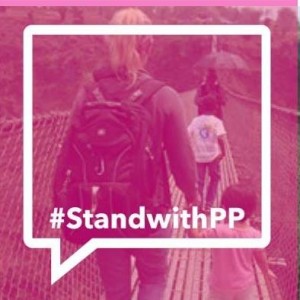
This month, I bring you a guest post which sheds light on current events, events that literally hit home for me when the Planned Parenthood clinic closest to my university was attacked by arsonists. I welcome back Jennifer Rothchild, Ph.D. Associate professor of Sociology and Coordinator of the Gender, Women, & Sexuality Studies (GWSS) Program at the University of Minnesota, Morris, she is one of the founders of the American Sociological Association’s section on the Sociology of Development. She currently researches gender and development, health, childhoods, and social inequalities by examining the intersections of gender, sexuality, and reproductive health in the United States and abroad.
___________________
“Choose mercy! While there is still time!” A man shouted to me as I walked into a Planned Parenthood office. I couldn’t see him, which made the comment oddly affecting. I kept my eyes forward and pushed through the front door.
More than 20 years ago, my friend Kat had told me about her first trip to Planned Parenthood. As she left that building, a woman standing outside approached her, grabbed her shoulders, and cried, “‘DO YOU KNOW WHAT YOU HAVE JUST DONE? DO YOU KNOW WHAT YOU HAVE DONE?’”
I will turn 45 this February, and yesterday was my first visit to Planned Parenthood. Shame on me: a self-proclaimed activist, and a gender and sexuality scholar. Until now, my privilege had allowed me to get all the women’s health care I needed through medical clinics and private practice physicians. All covered by insurance. But I knew Planned Parenthood was always there, should I ever need their services.
I had a health problem, and this time I chose Planned Parenthood because that is what it is: a health clinic. The woman at Planned Parenthood who booked my appointment warned me: “You should know that this clinic will have protesters. Turn into the parking lot, and a volunteer will help you get by the protesters, and then park.”
There are many misconceptions about Planned Parenthood; here are some facts:
- Planned Parenthood services include STD/STI (sexually transmitted disease/sexually transmitted infection) testing and treatment for both men and women, cancer screenings, contraception, abortions, and other health services.
- Abortions make up less than 3% of the services provided by Planned Parenthood.
- Federal funding for Planned Parenthood is only for Title X: restricted to family planning and STI testing.
- Planned Parenthood clinics that provide abortion services do not receive any federal funding, even if those particular clinics also provide services that meet Title X criteria.
On a rainy, cold morning, I arrived at Planned Parenthood, and a volunteer waved me into the parking lot. Next to this volunteer stood a protester, holding a sign about texting a certain number before “aborting.” I wondered if these two women talked to each other as they stood together in the rain?
Once inside, I was overwhelmed by a need to express gratitude to everyone I met. I assumed that most Planned Parenthood patients felt same way, if not always vocalizing their sentiments. But I was wrong. My intake nurse told me that just that morning a patient told her, “I hate who you are. I hate what you do. I don’t want to be here, but I need birth control pills.”
Her story made me wonder about the level of denial and disconnect that must be actively maintained to keep those ideas working side by side. In 2012, Frank Bruni wrote in the New York Times about a doctor who performed abortions:
He shared a story about one of the loudest abortion foes he ever encountered, a woman who stood year in and year out on a ladder, so that her head would be above other protesters’ as she shouted ‘murderer’ at him and other doctors and ‘whore’ at every woman who walked into the clinic.
One day she was missing. ‘I thought, ‘I hope she’s O.K.,’ he recalled. He walked into an examining room to find her there. She needed an abortion and had come to him because, she explained, he was a familiar face. After the procedure, she assured him she wasn’t like all those other women: loose, unprincipled.
She told him: ‘I don’t have the money for a baby right now. And my relationship isn’t where it should be.’
‘Nothing like life,’ he responded, ‘to teach you a little more.’
A week later, she was back on her ladder.
That morning, security was at a premium at the Planned Parenthood clinic: a guard stood at the front door, and I needed to show him identification. I was given a name tag that read only “Jennifer.” A few minutes later, “Jennifer R.” was summoned from the waiting room. I wondered how much money could be saved and put to better use if Planned Parenthood didn’t feel compelled by threats and attacks to spend on security measures.
In the waiting room I saw young and old women, white and black and Latina. There were men, too. I couldn’t imagine the individual stories that brought them to Planned Parenthood. But, I might have assumed they all shared was a lack of access and means to the kind of health care that should be their right. According to a 2012 report from the Government Accountability Office, 79% of people receiving services from Planned Parenthood lived at 150% of the federal poverty level or lower (that comes out to around $18,500 per year for a single adult). These people live in vulnerable conditions, where an unplanned pregnancy could result in future burdens, unfair and disproportionate in consequence.
If Planned Parenthood clinics are shut down, we will see not only tremendously diminished reproductive health but also epidemic numbers of unplanned pregnancies and unsafe abortions, as well as greater needs for social services such as WIC. Concerns for women’s health aside, Planned Parenthood delivers mercy upon people who benefit from its services.
The nurse practitioner spent time talking with me, getting to know me. I told her how grateful I was for the work she did. She graciously explained, “I started working here 15 years ago to educate women about their bodies. Women don’t know their bodies.”
Driving out of the parking lot, I stopped and rolled down my window to thank the same volunteer who had stood in the rain when I arrived, waving me into the parking lot. There was now a different protester. This woman was young, white, blonde, and wearing a pink raincoat. She could have been a twenty-something version of me. In her hand, she clutched a brochure limp from the rain. Her sad gaze followed me as I drove away. I wish she saw and knew the things I understood.
I also wish everyone understood that Planned Parenthood volunteers, nurses, and doctors risk their own safety and well-being because women’s health—and women’s lives—hang in the balance. These women and men are standing up and fighting for me, fighting for you.
“Choose mercy.” Yes, we should.

 Reading
Reading  Signs: Journal of Women in Culture and Society invites submissions for a special issue titled
Signs: Journal of Women in Culture and Society invites submissions for a special issue titled  Hooking up is getting lots of
Hooking up is getting lots of 

 This month The Man Files welcomes Sam Bullock writing his first guest post for Girl With Pen. In this personal account, Sam explains what happened when his Mormon religion collided with feminist politics.
This month The Man Files welcomes Sam Bullock writing his first guest post for Girl With Pen. In this personal account, Sam explains what happened when his Mormon religion collided with feminist politics.
 Much as I want to think of myself as a feminist parent, sometimes I doubt my credentials. After all, I don’t forbid
Much as I want to think of myself as a feminist parent, sometimes I doubt my credentials. After all, I don’t forbid 
